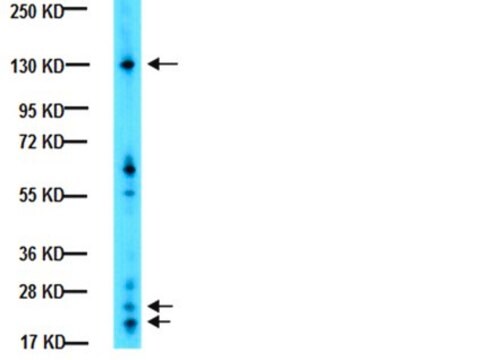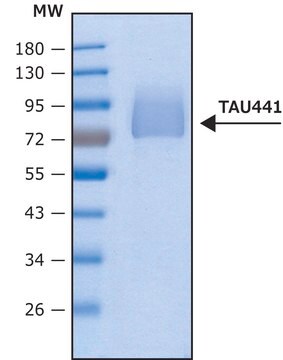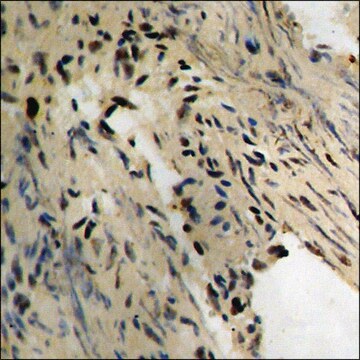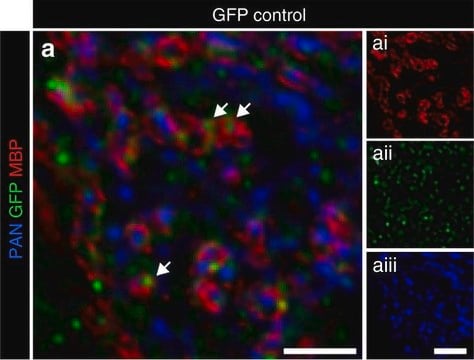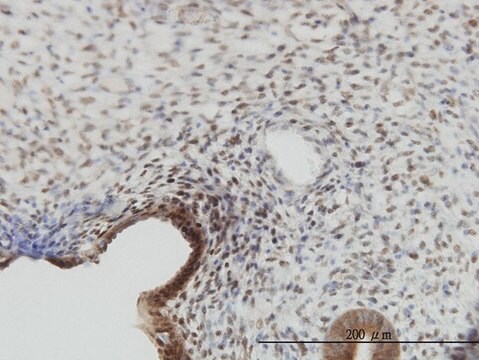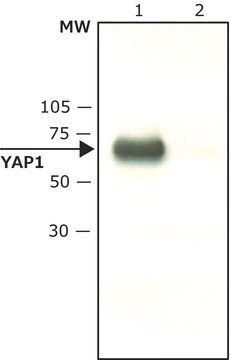MABN2275
Anti-phospho-Tau (Ser235) Antibody, clone RN235
clone RN235, from mouse
Synonyme(s) :
Microtubule-associated protein tau, Neurofibrillary tangle protein, Paired helical filament-tau, PHF-tau
About This Item
ELISA
IF
IHC
WB
dot blot: suitable
immunofluorescence: suitable
immunohistochemistry: suitable (paraffin)
western blot: suitable
Produits recommandés
Source biologique
mouse
Forme d'anticorps
purified immunoglobulin
Type de produit anticorps
primary antibodies
Clone
RN235, monoclonal
Espèces réactives
mouse, human
Conditionnement
antibody small pack of 25 μg
Technique(s)
ELISA: suitable
dot blot: suitable
immunofluorescence: suitable
immunohistochemistry: suitable (paraffin)
western blot: suitable
Isotype
IgG1κ
Numéro d'accès NCBI
Numéro d'accès UniProt
Modification post-traductionnelle de la cible
phosphorylation (pSer235)
Informations sur le gène
human ... MAPT(4137)
Description générale
Spécificité
Immunogène
Application
Dot Blot analysis: A representative lot detected phosphorylated recombinant human tau (pSer235), but not the non-phosphorylated recombinant human tau (Tau). (Courtesy of Rebecca Nisbet, Ph.D., University of Queensland, Brisbane, Austraila).
Immunofluorescence Analysis: A representative lot detected phospho-tau (Ser235) in K3 and rTg4510 tau transgenic mouse brains (Courtesy of Rebecca Nisbet, Ph.D., University of Queensland, Brisbane, Austraila).
Immunohistochemistry (Paraffin) Analysis: A representative lot detected phospho-Tau (Ser235) in human Alzheimer s disease (AD) brain tissue sections. (Courtesy of Rebecca Nisbet, Ph.D., University of Queensland, Brisbane, Austraila).
ELISA Analysis: A representative lot full-length human recombinant phospho-tau (Ser235) or GSK-3 beta phosphorylated tau (pTau), but not the non-phosphorylated tau (Courtesy of Rebecca Nisbet, Ph.D., University of Queensland, Brisbane, Austraila).
Western Blotting Analysis: A representative lot detected phospho-tau (pSer235) K3 tau transgenic mouse brain homogenates, but not in homogenates from tau knock-out (KO) (Courtesy of Rebecca Nisbet, Ph.D., University of Queensland, Brisbane, Austraila).
Neuroscience
Qualité
Western Blotting Analysis: 2 µg/mL of this antibody detected Microtubule-associated protein tau (pSer235) in brain tissue lysates from K3 transgenic mouse, but not in brain of microtubule-associated protein tau (MAPT) knock out mouse.
Description de la cible
Forme physique
Stockage et stabilité
Autres remarques
Clause de non-responsabilité
Vous ne trouvez pas le bon produit ?
Essayez notre Outil de sélection de produits.
Code de la classe de stockage
12 - Non Combustible Liquids
Classe de danger pour l'eau (WGK)
WGK 1
Point d'éclair (°F)
Not applicable
Point d'éclair (°C)
Not applicable
Certificats d'analyse (COA)
Recherchez un Certificats d'analyse (COA) en saisissant le numéro de lot du produit. Les numéros de lot figurent sur l'étiquette du produit après les mots "Lot" ou "Batch".
Déjà en possession de ce produit ?
Retrouvez la documentation relative aux produits que vous avez récemment achetés dans la Bibliothèque de documents.
Notre équipe de scientifiques dispose d'une expérience dans tous les secteurs de la recherche, notamment en sciences de la vie, science des matériaux, synthèse chimique, chromatographie, analyse et dans de nombreux autres domaines..
Contacter notre Service technique